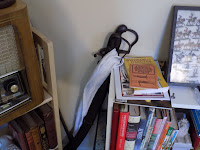On The Road to Lucknow: Indian Mutiny
Byron, at the head of the table, presides over his Indian Mutiny Game.
Byron is quite accomplished at running Brother Against Brother Indian Mutiny games, and he'll be bringing this game to the Historicon Convention in July.
Operation Charnwood, July 4, 1944: Iron Cross
Fellow blogger AJ briefing players for his Iron Cross Game pitting Canadians vs Germans.
Many Rivers To Cross: Okay Just One: Medieval--Franks vs Saracens
Michael B explaining his Have Fun Storming the Castles, Lads, home-brew system to players before the game.
This was the game I played in. Here is the description: A Saracen force attacks a crusader castle that guards a river crossing. They are too small a force to storm the castle, so the Saracens seek to burn the village that has sprung up in its shadow and to capture or kill the peasant workers and to take home the livestock before they can take shelter or flee across the river. I was among three Saracen players, and we were pitted against four Franks. It was something of a blur. I was in the center, so I basically took my two units (one of foot and one of horse) and charged down the middle of the table to cause as much havoc as possible and get as far as I could while my compatriots worked their way down the flanks. In short, I ran the gauntlet. The following panels give you an idea of how my mission came to be called the "Martyr's Charge"--I'll leave it to the end of this report to let you know whether or not we heroic defenders of the Holy Land prevailed over the Frankish interlopers.
The Franks Coordinating Their Move
My Main Striking Force strikes fear in the Franks. I had inadvertantly grabbed a leader figure (the fellow in blue) from a neighboring Saracen player (John) and used it along with my men-at-arms for most of the game. It took awhile to notice (as you'll see in this story).
The charge begins--Well, Mostly...
The Franks, in an act of desperation, move a line of foot in front of their crossbows...
...which the Saracens made them pay for, but with bowfire. In the next phase, the Saracen horse followed up with its charge, but the Franks had the countermove and so were able to slink out of contact. In the background can be seen fellow Saracen player Paul.
The Martyr's Charge hits home--sort of. This wound up being near the end of the game. The footare fellow Saracen John's, who had by then worked his way around on the right. Shortly after this, he would reclaim his leader figure (who survived the solo charge into the crossbows).
In the end, although a ferry full of peasants and livestock were gotten across the river, we had grabbed enough livestock, picked off enough peasants, and (most of all) caused enough destruction by putting the church to the torch to be declared victors over the Franks (although this was one of those victories that sure felt like a beating!).
Putting away the toys after the game
That concludes my report on our March Game Night, dear readers. In sum, it was another fine thing, to gather with friends and push toy soldiers at the end of the week.
Excelsior!

































